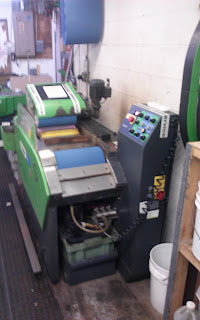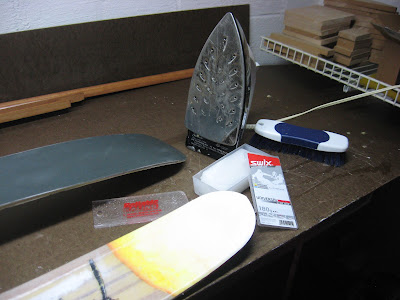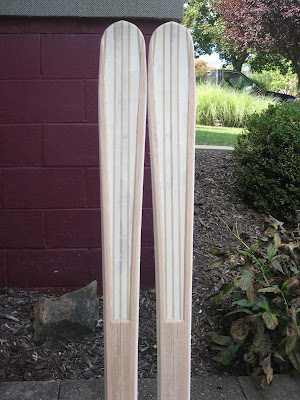This year I decided to use paper as my graphics medium as i did last year with the Panjshirs and Arlias. Paper works well because it is a lightweight medium that is very easy to achieve great detail with. I have used cotton cloth in the past to get very opaque colors, but it adds weight to the ski and can be hard to paint on. Paper also becomes semi-transparent when wetted with the epoxy which allows the wood core to show through. The wood core I design this year has aspen (light), poplar (medium), and red oak (dark brown-red) which makes for a very nice look.
Acrylic paint was used to design the graphics. Acrylic paint dries fast, is cheap, and seems to bond well to the epoxy. I recruited my sister Emily, an art major, to help me design the graphics again this year. The name of the ski and graphics theme is Aftermath.
Aftermath is defined as something that results or follows from an event, especially one of a disastrous or unfortunate nature; consequence: the aftermath of war; the aftermath of the flood.
In the case of my skis, a
coniferous forest is being blown away, smoke rises from the forest and light from the explosion is being reflected on mountains at the tail of the ski. The theme of the ski is not destruction, but power. My initial concept is below and yes, I know I am not the greatest artist - that is why I brought in Emily.
After some internet searching I came across a certain
video and took a screenshot. This became the main inspiration for the design.
Once Emily arrived, we rolled out the paper and began the design.
The paint was applied in stages. Here you can see the background.
More layers were applied.
And more layers.
Finally, after 8 hours of painting we had the graphic below. Although Emily did most of the work, I did help with the painting (in case you wondered).
I used microsoft paint to patch together the full graphic. The hardest part about painting this graphic is that the paper was white; when applied to the ski, the trees and graphics will have a wood background.
Once the painting was done, I painted a line at boot center (for binding mounting) and I cut the graphic in half to apply to both of the skis.
The next step was the second press stage in which a layer of fiberglass, the graphic, and a top sheet would be applied to the ski. In order to press the ski efficiently, I staged all the materials beforehand. I also wiped down the core and top sheet to remove any dust.
The 2 inches of foam shown in the image below was used to ensure that the top sheet wrapped around the contours of the ski. I have used this in years past successfully. This year the skis have rails on the top and I was concerned that the top sheet might not wrap the full contour.
The pressing went very well and the topsheet wrapped around all the contours well. Some excess epoxy and bubbles exist near the binding plate, but nowhere else. The pressed skis are below.
After the epoxy has a few days to fully cure, the flashing will be trimmed and edges, tip, and tail will be sanded smooth.





























































